Finite-Time Distributed Cooperative Guidance Law with Impact Angle Constraint
Abstract
The problem of the distributed cooperative guidance law of multiple missiles attacking a stationary target with impact angle constraint is investigated. A distributed cooperative guidance law, which consists of a nonsingular terminal sliding mode component for ensuring finite time convergence to the desired LOS angle and a coordination component for realizing finite time consensus of time-to-go estimates, is proposed. Analysis shows that the guidance law designed in this study can ensure that missiles’ time-to-go estimates represent real times to go once all the missiles fly along the desired LOS. Therefore, simultaneous arrival can be guaranteed. Furthermore, it is modified to accommodate the communication failure cases. Compared with existing results, this guidance law owns faster convergence rate and can satisfy large impact angles. Numerical simulations are performed to demonstrate the effectiveness of the proposed guidance law.
1. Introduction
Modern battleships are usually mounted with formidable antimissile defensive systems, such as close-in weapon systems that have powerful fire capability. These defensive weapons seriously intimidate the survivability of the conventional antiship missiles. Hence, advanced missile guidance technique is becoming important issue such as the impact angle control guidance (IACG) and cooperative guidance, which aims at, in a specific case, making multiple missiles arrive at a single target simultaneously to saturate the target’s defence [1–5].
Up to now, there are two ways to achieve simultaneous attack of a group of missiles, i.e., the “open loop” and the “closed loop”. The first one usually refers to the impact time control guidance (ITCG), in which a fixed impact time is assigned to each missile, and each member tries to attack the target at the prespecified impact time independently. Some studies based on such method include [1, 6–8]. In [1], a sliding mode control-based guidance law for the impact time control is proposed. Firstly, a switching surface is defined by considering the impact time constraint; then, the guidance law is designed to drive the switching surface to the sliding mode for fulfiling the impact time requirement. In [6], an optimal-theory-based guidance law is presented, in which the acceleration commands are composed of two different commands: the first one serves to reduce the miss-distance, and the second one serves to adjust the impact time. In [7], a novel guidance law is proposed for salvo attack which can satisfy the constraints of both impact time and terminal impact angle. The control of impact time and angle is achieved by making the states of the missile reach a sliding surface within finite time and then stay on it. On the sliding surface, the impact time and angle constraints will be satisfied, which can be verified through analyzing the system dynamic in state space. In [8], an impact time control guidance law is also designed based on sliding mode control. The interception and the desired impact time can be achieved at the same time in the sliding mode. The first approach requires a reasonable common impact time that must be preprogrammed manually before homing. However, choosing a proper common impact time is not an easy task because it is associated with the missiles’ flight conditions in the future, which are usually varying and unknown.
The second one usually refers to consensus-based cooperative guidance, in which the missiles communicate among themselves through online data links to synchronize the arrival times. Despite a number of papers, considering IACG have been published [9–12], papers related to cooperative guidance law for salvo attack are still rare. In [2], a guidance law named cooperative proportional navigation (CPN) is proposed for many-to-one engagements. The structure of the CPN is the same to that of conventional proportional navigation. The difference is that it has a time-varying navigation gain which is adjusted based on the local time-to-go and the time-to-go of all the other missiles. In [13], a modified cooperative guidance law is proposed to address the singularity problems existing in the work of [2]. In [14], optimal and cooperative control methods are used to design the guidance law, in which the missiles need only to communicate with some of the neighboring missiles. In [15], a cooperative guidance law for two pursuers against one evader is derived, which is also based on optimal theory. The approaches in [2, 13–15] can only guarantee the consensus of arrival time but cannot control the impact angles. Besides, the approaches in [2, 13] require that the global information of the time-to-go is available to each missile of the group. In [16], a distributed cooperative guidance law is designed for cooperative simultaneous attack against a stationary target. Similar to [2], a PN structure with time-varying navigation gain is also used to derive the guidance law. However, the design does not take impact angle into consideration. In [17], the derived guidance law consists of two terms: a local term that takes charge of the target capture and the desired impact angle, and a coordinate term to achieve the consensus of impact time. In [18], the distributed optimal tracking control problem for nonlinear multiagent systems is investigated, and the derived method is applied to the cooperative guidance problem. The guidance law design does not take the simultaneous arrival as its control object; instead, it only focuses on the consensus of the impact angle of all the missiles.
Besides, there are some sliding mode control- (SMC-) based cooperative guidance laws [19, 20]. In [19], a distributed cooperative guidance law is presented to make multiple missiles attack the same target simultaneously at the prespecified angles. The guidance process under this guidance law can be divided into two stages: in the first stage, the normal acceleration which is designed based on SMC makes all missiles fly along the desired line of sight (LOS) after a given time; then, the designed tangential acceleration will make the consensus variables reach agreement. In [20], a three-dimensional guidance law is proposed based on the method in [19]. For the approaches in [19, 20], the given time for the first stage needs to be chosen as a large constant to reduce the control input; contradictorily, too large given time will prevent the missiles from arriving at the target simultaneously because the second stage needs enough time to ensure that the consensus variables converge to zero. Besides, the desired impact angles also need to be selected carefully.
In this paper, a distributed cooperative strategy for multiple missiles with impact angle constraint is proposed. The guidance law consists of two components: a nonsingular terminal sliding mode component for ensuring finite time convergence to the desired LOS angles and a coordination component for realizing finite time consensus of the time-to-go estimates of all the missiles. The proposed strategy can ensure that missiles’ time-to-go estimates represent the real time-to-go once all the missiles fly along the desired LOS. Furthermore, the guidance law is modified to accommodate the communication failure cases.
- (1)
Compared with the guidance laws in [2, 13], which rely on a centralized communication topology, the method presented in this paper only employs neighbour-to-neighbour communication, and thereby, it is fully distributed. Since the centralized communication topology is difficult to be maintained in realistic situation, the proposed method is more practical
- (2)
Unlike the guidance laws presented in [2, 13–15, 21–23], which only investigate the simultaneous arrival problem of multiple missiles, this study provides a strategy that can guarantee that all group members arrive at the target at the same time by imposing the preassigned impact angles. As a result, the mission effectiveness can be greatly increased [24].
- (3)
Compared with the guidance laws in [2, 17], which only focus on the convergence of LOS angle errors or the consensus of time-to-go estimates, the method proposed in this paper can achieve finite time convergence of both LOS angle and consensus errors. As we know, the systems with finite-time convergence property usually possess some nice properties, such as better robustness against uncertainties and higher convergence precision
The organization of the paper is as follows. The problem formulation and some preliminaries are provided in Section 2. In Section 3, the distributed guidance law for simultaneous attack of multiple missiles is constructed based on finite control technique. Furthermore, the guidance law is modified to adapt to communication failure cases in Section 4. The simulation results are given in Section 5. Finally, concluding remarks are summarized in Section 6.
2. Problem Formulation and Preliminaries
In this section, we give the problem formulation and some preliminaries.
2.1. Problem Formulation
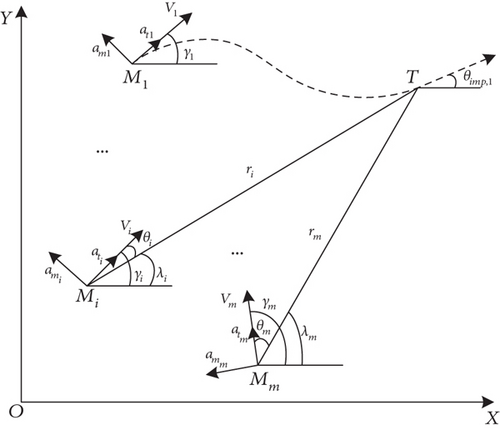
where θi = γi − λi and di stands for the lumped disturbance, which satisfies |di| ≤ Di with Di denoting an unknown positive constant. It should be noted that the condition |θi| < π/2 is necessary for the extremization problem to make sense [24]; as implied by (1), the impact can be indefinitely delayed, if this condition does not hold.
Remark 1. Similar to the work in [2], the target is modeled as being stationary, since the maneuverability and the speed of the surface ship are not comparable with those of antiship missiles of high-subsonic or supersonic speed.
For the ith missile, (7) denotes the relationship between the impact angle θimp,i and the final LOS angle λF,i.
2.2. Preliminary
2.2.1. Graph Theory
Let be used to describe the communication topology among missiles, where is a set of the node set denoting the index of missiles, is the set of edges, and a weighted adjacency matrix . If there exists information exchange between missiles i and j, i.e., , then aij = aji = 1, and zero otherwise. We assume that aii = 0 for all . The Laplacian matrix is defined as and lij = −aij for i ≠ j.
The following lemmas are needed in the subsequent technical derivations.
Lemma 2 (see [25].)Zero is an eigenvalue of , with 1 as a right eigenvector, and all nonzero eigenvalues are positive, where 1 represents a column vector whose entries are all equal to one.
Lemma 3 (see [26].)The Laplacian matrix of a connected undirected graph has the following properties: for any satisfying 1Tx = 0, the inequation holds, where denotes the smallest nonzero eigenvalue of .
3. Main Results
In this section, the special structure of the proposed guidance law which contains two components is presented first; then, the component concerning the impact angle control is derived based on nonsingular terminal sliding mode, and the sufficient condition for stability is given. Lastly, the other component concerning the consensus of time-to-go estimates will be designed based on the finite-time control technique and the consensus protocols.
3.1. The Structure of the Proposed Guidance Law
where the term a1,i is used to control the impact angle and the term a2,i together with the tangential acceleration at,i is used to guarantee the consensus of time-to-go estimates.
3.2. Design of the Impact Angle Control Term a1,i
is used to design a1,i to ensure that the λi = λF,i condition is met at collision. As proved in [27], the |θi| = (π/2) is not a stable equilibrium for any ri ≠ 0 and, as a result, the component of normal acceleration a1,i can be used to control λi.
Theorem 4. For the ith missile subjected to the kinematics (1), (2), (3), and (4), if the sliding surface is selected as (11), the control term a1,i is designed as (12), (13), and (14), and control parameters are chosen to satisfy Mi > max{a2,i}, β > 0; pi and qi are two odd integers guaranteeing pi > qi; then, will converge to λF,i and 0 in finite time, respectively.
Proof. Consider a Lyapunov function candidate as on differentiating VL1, and substituting (10), (12), (13), and (14) and simplifying, we obtain
Recall that the point |θi| = (π/2) is not a stable equilibrium, so we assume that for most time during the engagement, cosθi has a nonzero value. Let
where ζ > 0 with Mi > max{|a2,i|} for . Therefore, is the negative definite, and hence, the condition for Lyapunov stability is satisfied for all , and, consequently, the sliding mode occurs within finite time. During the sliding mode si = 0, the sliding mode dynamics is given by
where the state xi = λi − λF,i. On integrating (18), it can be shown that the time required for the state x to reach 0 is Tc,i > 0 and is given by
Here, a problem remains (i.e., is negative-semidefinite), which implies that the sliding mode cannot occur when in the reaching phase. Therefore, it is necessary to show that is not an attractor. To show this, analyze the dynamics of . On substituting (12), (13), and (14) into (10), we get
Now, for , (20) reduces to
Since ri, cosθi have nonzero values, and Mi > max{|a2,i|}, for si > 0 and si < 0, it can be seen from (21) that , which implies that is not an attractor. Therefore, from any arbitrary initial point, the desired LOS angle λF,i can be achieved within finite time with a1,i.
This completes the proof.
3.3. Design of the Coordination Terms a2,i and at,i
In this subsection, the terms a2,i and at,i which will ensure the consensus of time-to-go estimates are designed based on consensus protocols and finite-time control technique, and a proof for the stability is given by the Lyapunov theory.
where N0 ∈ [3, 5] [28] and ρ > 0. Note that the gain ρ can be used to modify the curvature of the flight trajectory while attacking a specified final position. In general, the missiles located far from the target should use a high gain ρ to reduce the flight time, whereas those closer should use a low gain ρ to provide a detour intentionally. Therefore, the time-varying gain plays an important role not only for achieving zero miss distance but also for tuning the time-to-go.
where k3i and k4i are positive constants that satisfy k3i > max{|a1,i|} and k4i > Di. In the following, three lemmas are given first, and then the finite time convergence of ξi is validated in Theorem 8.
Lemma 5 (see Appendix A.)If the control parameters αi and βi are properly chosen, then the point θi = 0 will not be a stable equilibrium before ξi converge to zero.
Lemma 6 (see [29].)For positive variables a1, a2, ⋯, an and 0 < p < 2, the following inequality holds
Lemma 7 (see [30].)If there exists a continuous positive function V(x) such that
where a > 0, b > 0, and 0 < μ < 1; then, V(x) will converge to zero in finite time, and the settling time T satisfies
Theorem 8. For the ith missile subjected to the kinematics (1), (2), (3), and (4) and the communication graph , if the control term a1,i is designed as (12), (13), and (14), the term a2,i is designed as (23), (24), and (27), and the tangential acceleration at,i is designed as (28); then, the consensus of the time-to-go estimates will be achieved in finite time, and the m missiles will arrive at the target simultaneously with imposing the desired impact angles.
Proof. Expand sinθi and cosθi in the Taylor series as
In general cases, the heading angles of each missile are small. Hence, the high-order terms in the above equations can be neglected. Then, the governing equations of the ith missile can be expressed as
On differentiating and substituting (33), (34), and (35) into it, we get
Let and ξ = [ξ1, ⋯, ξm]. Then, (25) can be written as . Consider the following Lyapunov function candidate:
Differentiating VL2 with respect to time and substituting (36) into it yields
where is used. According to Lemma 5, and without loss of generality, we assume . Define
Then, by using Lemma 6, we can obtain
Since , holds. It follows that . According to Lemma 2 and Lemma 3, we have , i.e., . Hence, (38) can be written as
According to Lemma 7, VL2 converges to zero within
which means ξ will converge to zero in finite time. Therefore, the finite time consensus of the time-to-go estimates of all missiles can be guaranteed.
Remark 9. Note that (26) only represents time-to-go estimates, so it is important to show how all the missiles hit the target simultaneously with the proposed guidance law. From (2), it can be seen that θi = 0 when . Assume that mini=1,⋯,m{Tc,i} > Tr1, which can be guarranteed by the properly selected control parameters; then, we have am,i = 0, at,i = 0, i = 1, ⋯, m for any t > maxi=1,⋯,m{Tc,i}, which means all the missiles will flight toward the target straightly along the desired LOS. Besides, the velocities of the missiles no longer change. For t > maxi=1,⋯,m{Tc,i}, the time-to-go estimate in equation (26) reduces to tgo,i = ri/Vi, i = 1, ⋯, m, which represents the real time-to-go. As a result, all the missiles will arrive at the target simultaneously, and the impact angle constraint can be satisfied.
4. Modified and Extended to Communication Failure Cases
In the design process of a2,i and at,i mentioned above, we have assumed that the communication graph among the missiles is undirected and connected. In this section, communication failure cases will be investigated, and the guidance law is modified.
Theorem 10. For the ith (i = 1, ⋯, m) missile subjected to the kinematics (1), (2), (3), and (4) and the communication graph . If the control term a1,i is designed as (12), (13), and (14), the term a2,i is designed as (43), and the tangential acceleration at,i is designed as (44); then, the consensus of time-to-go estimates of all the missiles will be achieved in finite time, and the m missiles will arrive at the target simultaneously with imposing the desired impact angles.
Proof. If there exists a time interval when some group members undergo communication failures, then the control terms a2,i and at,i of all the missiles are switched to
Then, the governing equations (33), (34), and (35) change into
Differentiating and substituting (46), (47), and (48) into it yields
Hence, the integral of (49) can be computed as
As a result, the Lyapunov function VL2 can be denoted as
where we assume that the graph always shares the same adjacency matrix with , so as to analyze the dynamics of VL2 in the communication failure situation. (51) shows that the Lyapunov function candidate VL2 keeps invariant when some missiles are undergoing communication failures.
Otherwise, if there exists a time interval when the communication among the missiles is normal, which means the communication topology is equal to , we will have
Let (t0, t1) be the first time interval when such case occurs. Then, ∃η0, η1 > 0, such that ι1(t) > η0, ι2 > η1, t ∈ (t0, t1). Likewise, let (t2, t3) be the second time interval when such case occurs. Then, ∃η2, η3 > 0, such that ι1(t) > η2, ι2 > η3, t ∈ (t2, t3). Continuing this way, from (53), we can obtain
Then, one can deduce that integrating the inequalities in (54) over each time interval yields (see Appendix B)
where . From (55), one can imply that ∃0 < t1 < ⋯<tn−1, such that
for all t > 0, where denotes the total communication failure times. Therefore, from (56), we can say that VL2 converges to zero at a finite time Tr2 bounded as
Hence, the consensus of time-to-go estimates can be achieved in finite time. By following Remark 9, we can conclude that all the missiles that participated in the cooperative attack will arrive at the target simultaneously, and the desired impact angles can be achieved.
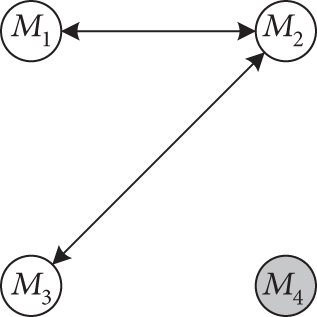
5. Simulation and Results
| Missile number | Initial position | Initial heading angle | Speed | Designated impact angle | Initial impact time |
|---|---|---|---|---|---|
| Missile 1 | (-7000, 2000) m | 40 deg | 260 m/s | -80 deg | 29.36 s |
| Missile 2 | (-9000, -4500) m | 20 deg | 290 m/s | -30 deg | 35.12 s |
| Missile 3 | (-6000, -6500) m | -20 deg | 210 m/s | 70 deg | 42.63 s |
| Missile 4 | (-3000, -10100) m | 10 deg | 320 m/s | 120 deg | 33.02 s |
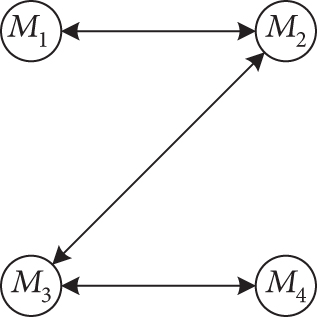
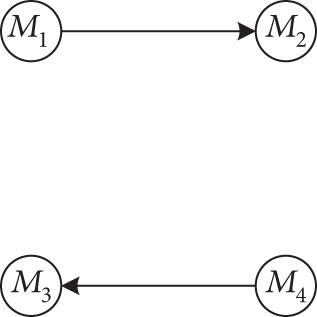

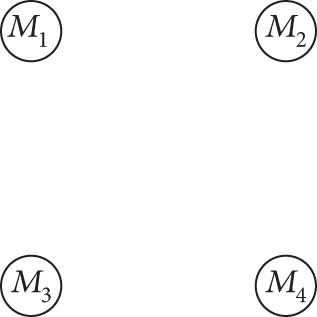
Besides, the lumped disturbances are assumed as d1 = 2.2sin(2.4t), d2 = 1.5sin(4.5t), d3 = 3.4sin(1.4t), and d4 = 1.2sin(3.2t).
5.1. Case 1: Undirected and Connected Communication Topology
For this case, the communication topology is assumed to be fixed at as shown in Figure 3(a). Simulation results for case 1 are presented in Figure 4. Figure 4(a) depicts the ranges to go ri, which demonstrates that the FTDCG-IAC law can achieve simultaneous attacks under an undirected connected communication topology, and the arrival time is 42.34 s. The trajectories are shown in Figure 4(b). For comparison, the trajectories under the NTSMCG-IAC law [9], which are represented by lines in pink, are also included. It can be seen from Figures 4(c)–4(e) that the condition λi = λF,i, θi = 0, i = 1, ⋯, 4 is achieved about at 40s. After that, the tangential acceleration at,i and the normal acceleration am,i keep zero values, which is demonstrated in Figures 4(f) and 4(g). As a result, the FTDCG-IAC law degrades into the NTSMCG-IAC law and then steers the missiles to flight toward the target. This verifies the analysis in Remark 9. Note that the final LOS angles for the four missiles read -80.002°, -29.9959°, 69.9998°, and 119.9830°, respectively. Compared with the designated final LOS angles listed in Table 1, the final LOS angle errors are negligible. Figures 4(h) and 4(i) show the consensus errors of time-to-go estimates ξi and time-to-go estimates tgo,i, respectively. As we see from Figures 4(h) and 4(i), the time-to-go estimates achieve a fast consensus in finite time.
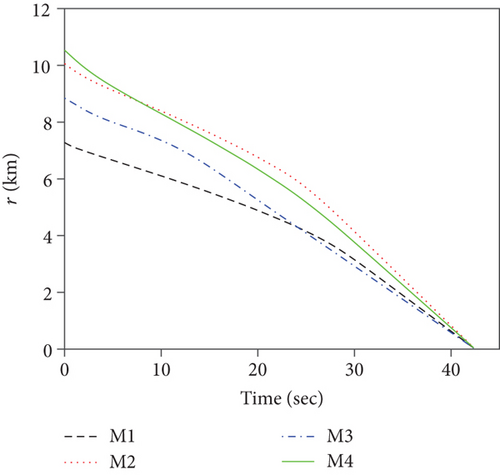
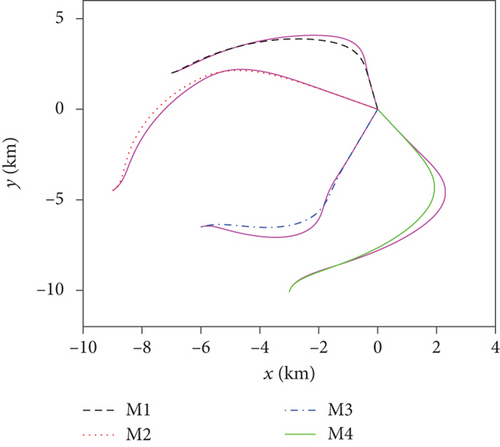

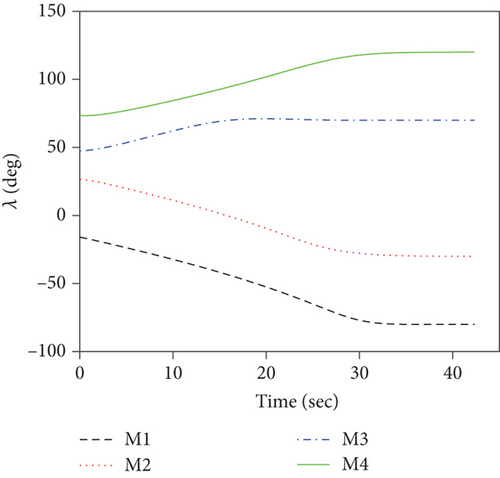
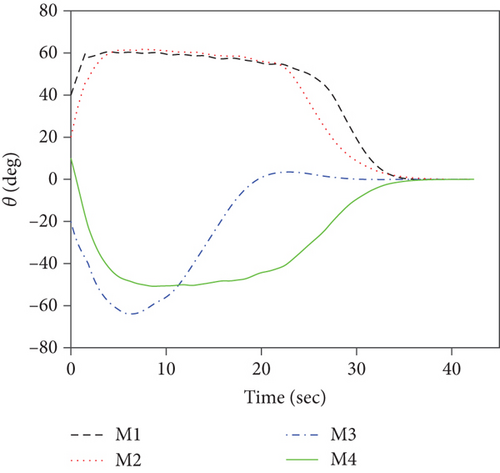
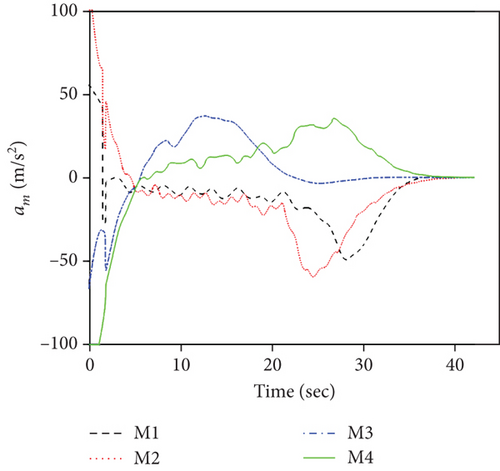
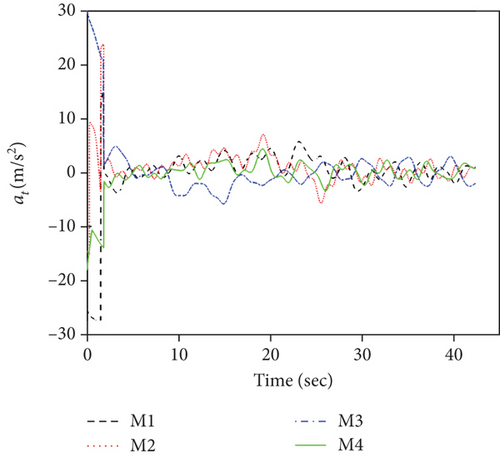
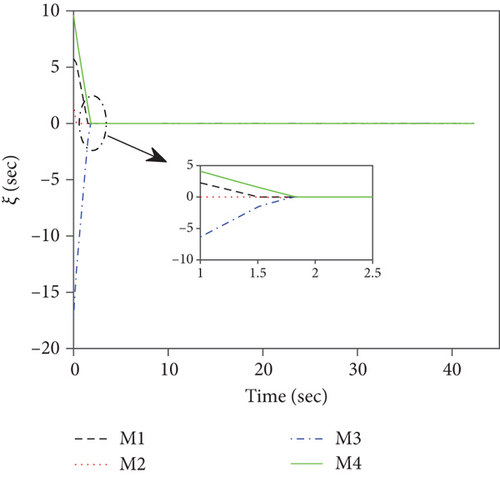

5.2. Case 2: Study on Communication Failure Situations with First-Order System Lag and LOS Rate Measurement Noise
For this case, we assume that communication failure situations occur during the time interval (2 s and 4 s; 12 s and 16 s; and 24 s and 26 s), and the corresponding communication topologies are represented in Figures 3(b)–3(d), respectively. For the rest time of the engagement, the communication topology can still be represented in Figure 3(a). The autopilots are modeled as first-order lag systems with time constants τ1 = 1/3, τ2 = 1/3, τ3 = 1/4, τ4 = 1/4. Besides, we assume the LOS rate measurents are suffered by white noise. The simulation results for case 2 are presented in Figure 5. As we see from Figures 5(a) and 5(b), the FTDCG-IAC law can still achieve simultaneous attacks for this case, and the arrival time is 40.24 s. From Figures 5(c)–5(e), we can observe that the condition λi = λF,i, θi = 0 can also be achieved, which is important for the simultaneous attacks. Figures 5(f) and 5(g) depict the histories of normal acceleration am,i and the tangential acceleration at,i, respectively. It can be seen that, once the communication topology among the missiles is back to normal, the control inputs suddenly change. This is due to the switching mode of the controllers and is important to reduce the consensus errors ξi as we see in Figures 5(h) and 5(i). From Figure 5(h), we can also observe that during the communication failure time intervals, the consensus errors ξi only change slightly, which is due to the sigmoid functions (58) and (59).
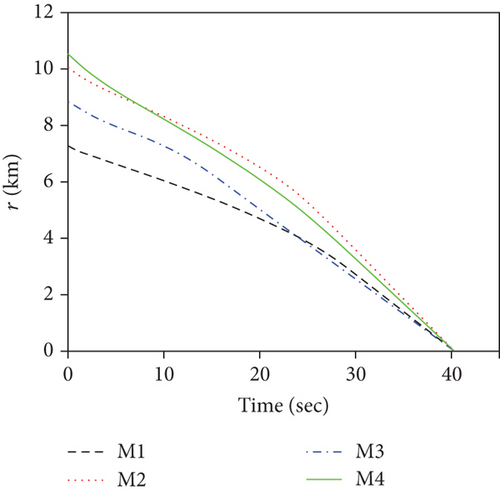

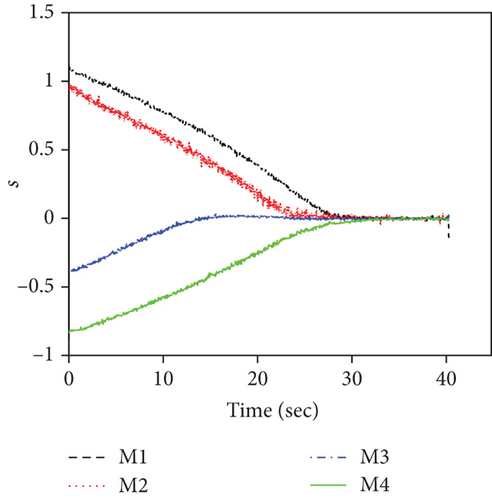

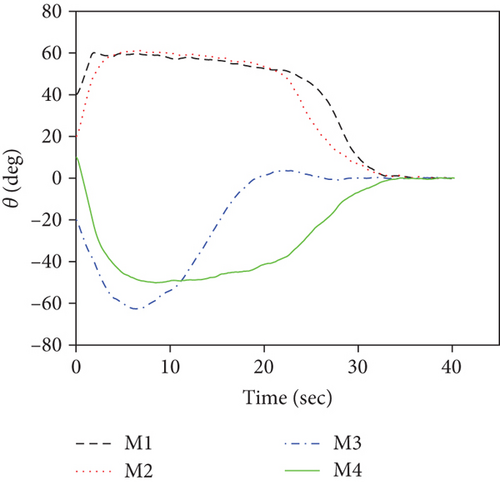
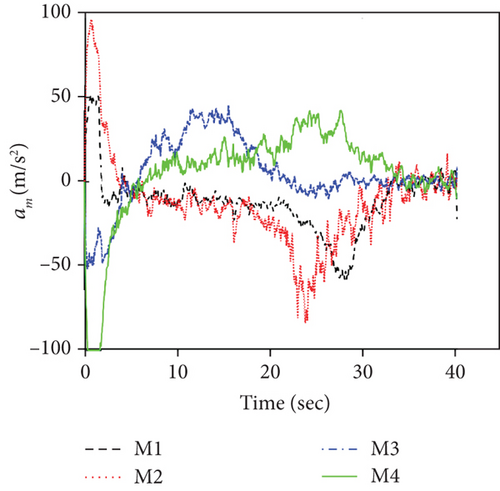
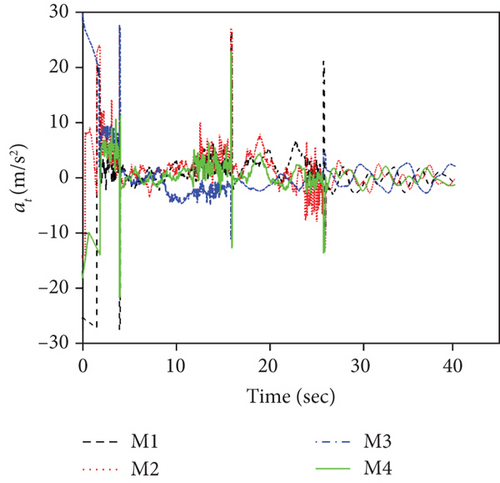
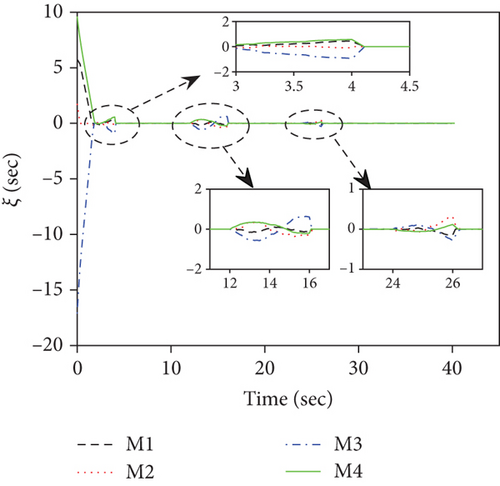
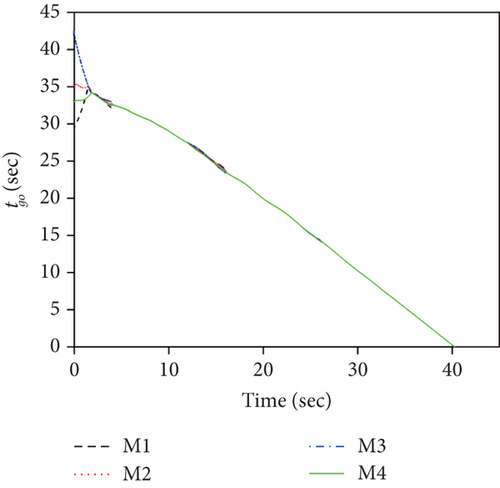
5.3. Case 3: Comparative Analysis
This set of simulations aims at providing comparative studies between the FTDCG-IAC law and the approaches outlined in [19, 20] (two-stage DCG-IAC) and [17] (DCBPNG-IAC). For fair comparison, the initial conditions for the missiles are the same with that in case 1 and case 2, except that the desired impact angles are reset as follows: θimp,1 = −30∘, θimp,2 = 40∘, θimp,3 = 60∘, θimp,4 = 55∘. The control parameters of the comparison methods are listed in Table 2. To achieve a fair comparison, the lumped disturbances di are set as zeros. Simulation results for case 3 are presented in Figure 6. In Figure 6(a), we can see that all three methods can achieve simultaneous attack, and the achieved arrival times are 37.692 s,34.08 s, and 42.72 s. Figure 6(b) shows the trajectories of missiles. As we can see from this picture, the missiles under DCBPNG-IAC take larger detours after the control begins; thus, the shaped trajectories are more curved. This is due to the fact that DCBPNG-IAC cannot adjust the magnitude but only the direction of the speed to synchronize the missiles’ arrival times. Although the generated homing trajectories are different, the desired terminal constraints are satisfied as shown in Figure 6(c). In Figure 6(d), which shows the normal acceleration histories, it is observed that the two-stage DCG-IAC generates larger control inputs than the other two methods during the first stage [0, Tc], and DCBPNG-IAC does so to satisfy the impact angle constraints during 20 s and 42.72 s. In general, the two-stage DCG-IAC law and DCBPNG-IAC law demand much more control effort in normal acceleration than the proposed FTDCG-IAC law does as shown in Figure 6(e), which depicts the cost function variations. Note that, in the two-stage method, the time interval [0, Tc] stands for the first stage, during which the desired final LOS angles will be ensured, and the time interval (Tc, tF) stands for the second-stage, during which the time-to-go estimates will reach an agreement. In order to reduce the control inputs in the first stage, the parameter Tc should be chosen as a large constant. The contradictory thing is that the second stage needs enough time as well to drive the consensus error to its origin. Besides, the initial LOS angle errors should not be allowed to be very large. Figure 6(f) shows the tangential acceleration histories. One can observe that the two-stage DCG-IAC law also generates larger control inputs during the first stage [0, Tc]. As mentioned above, large normal accelerations are generated to achieve the desired LOS during the first stage; therefore, large tangential accelerations are needed to counteract the effects brought by the normal accelerations. Figures 6(g)–6(i) show the speed variations of the missiles, the consensus errors ξi, and the time-to-go estimates tgo,i, respectively. As we see from the last two pictures, consensus errors of the time-to-go estimate under the FTDCG-IAC law converge to zero faster than the other two methods, and those under the two-stage DCG-IAC law are only kept bounded during the time interval [0, Tc].
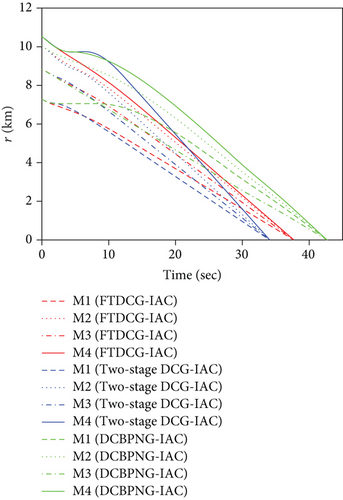

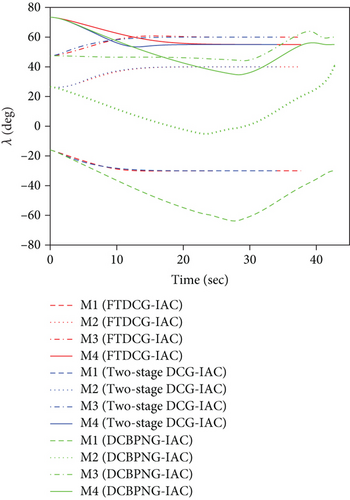
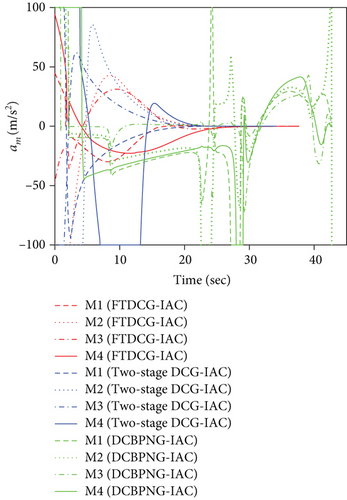
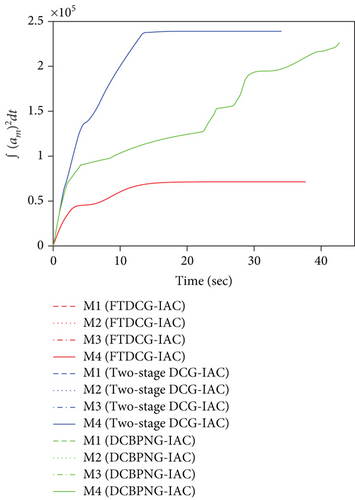
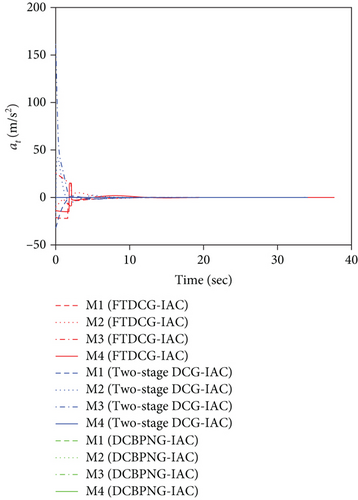
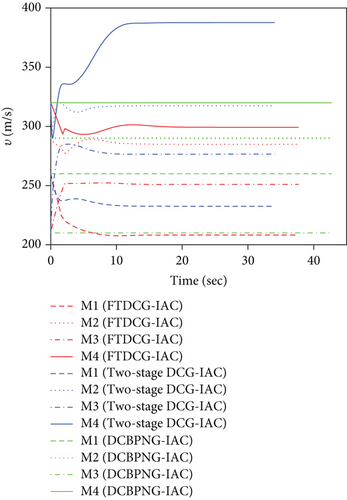
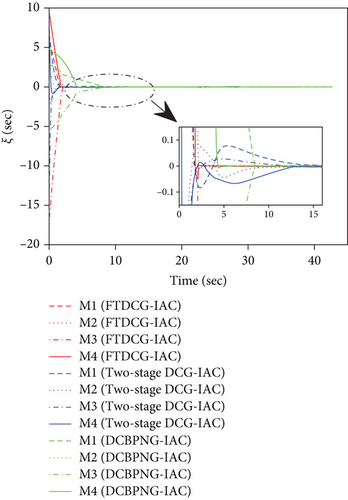
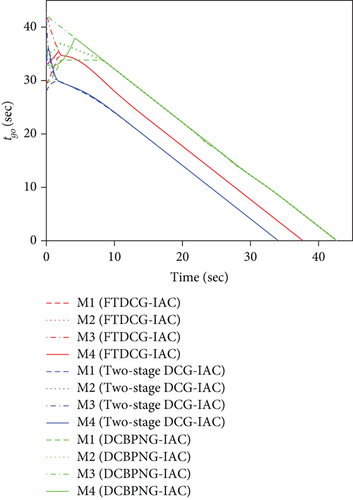
6. Conclusion
This paper studies the finite-time distributed guidance law design for cooperative simultaneous attack against a single target of multiple missiles with impact angle constraint. First, the guidance law which consists of two components is proposed. Wherein, a nonsingular terminal sliding mode component is designed for ensuring finite time convergence to the impact angle constraint, and a coordination component is designed for realizing finite time consensus of the time-to-go estimates. The guidance law can ensure that missiles’ time-to-go estimates represent the real time to go once the LOS errors converge to zero. Therefore, all missiles will hit the target simultaneously along the desired LOS. Then, the guidance law is modified and extended to communication failure cases. Compared with existing results, this guidance law owns better performance and is more flexible in assigning impact angles. In the future, we will expand this work to three-dimensional cooperative guidance law by considering more practical factors, such as overload constraints.
Conflicts of Interest
The authors declare that there is no conflict of interest regarding the publication of this paper.
Acknowledgments
This work is supported by the Natural Science Foundation of the Jiangsu Higher Education Institutions of China (23KJB120014).
Appendix
A. Proof of Lemma 3
From (A.1), it is clear that θi = 0 is not a stable equilibrium for si ≠ 0. From (16) and (17), it can be seen that the convergence rate of VL1 depends on the control parameters αi and βi. Therefore, if the parameters αi and βi are properly chosen, then θi = 0 will only happen momentarily when ξi ≠ 0.
B. Proof of Eq. (55)
Open Research
Data Availability
The underlying data used to support the findings of this study are available from the corresponding author upon request.




